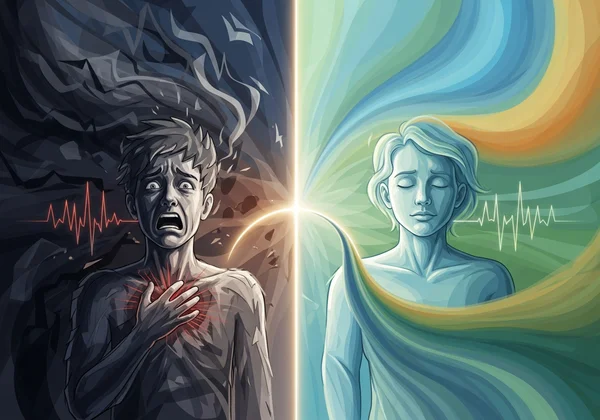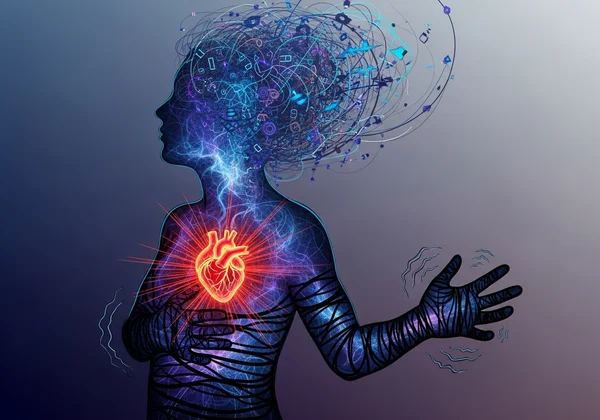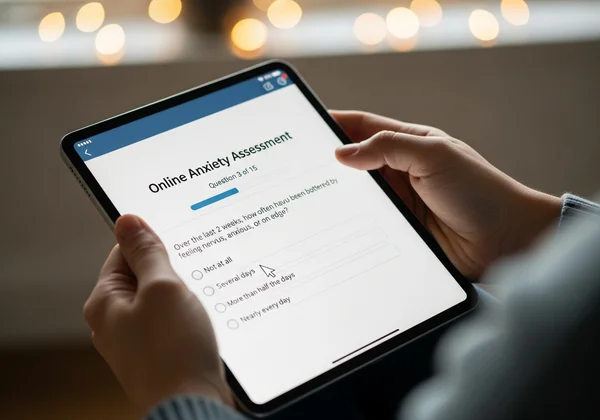Panic Attack: Symptoms, How to Stop, and When to Take an Anxiety Test
The world suddenly shrinks. Your heart hammers against your ribs, your breath catches in your throat, and an overwhelming wave of dread washes over you. It feels like you’re losing control, or worse, facing imminent danger when there is none. If this sounds familiar, you may have experienced a panic attack. It’s a terrifying and isolating event, but you are not alone. Understanding what is happening to your body and mind is the first, most powerful step toward regaining control. This guide is here to walk you through it. How can I test myself for anxiety that might be contributing to these feelings? A confidential online anxiety assessment can be a great starting point for clarity.
This article will explore the symptoms of a panic attack, provide immediate, actionable strategies to stop one in its tracks, and help you understand when it might be time to seek further insight through an anxiety test or professional support.

Understanding Panic Attack Symptoms and What They Feel Like
A panic attack is a sudden episode of intense fear that triggers severe physical reactions when there is no real danger or apparent cause. It’s more than just feeling nervous; it's a full-body response that can be incredibly frightening. Recognizing the symptoms is crucial for managing them.
What Exactly is a Panic Attack vs. General Anxiety?
While often used interchangeably, panic and general anxiety are different. General anxiety is typically a persistent, excessive worry about various things—work, health, or social interactions. It tends to build gradually and can last for a long time. Understanding this difference is key, and a generalized anxiety disorder test can help clarify if your baseline anxiety is high.
A panic attack, however, is a sudden surge. It peaks within minutes and is characterized by its intensity and abrupt onset. While someone with an anxiety disorder can experience panic attacks, the attacks themselves are distinct events. Think of general anxiety as a long, simmering drizzle, while a panic attack is a sudden, intense thunderstorm.
Common Physical Signs You're Having a Panic Attack
Your body's "fight or flight" response goes into overdrive during a panic attack, leading to a cascade of physical symptoms. You don't need to experience all of them for it to be a panic attack, but a combination is common:
- Racing Heart or Palpitations: A feeling that your heart is pounding, fluttering, or skipping beats.
- Shortness of Breath: A sensation of smothering or being unable to get enough air.
- Chest Pain or Discomfort: Often mistaken for a heart attack due to its intensity.
- Trembling or Shaking: Uncontrollable shaking in your hands, legs, or entire body.
- Sweating, Chills, or Hot Flashes: Sudden changes in body temperature.
- Nausea or Abdominal Distress: Feeling sick to your stomach.
- Dizziness or Lightheadedness: A feeling you might faint or lose your balance.
- Numbness or Tingling Sensations: Often felt in the hands, feet, or face.
The Overwhelming Mental & Emotional Experience
The physical symptoms are only half the story. The psychological component of a panic attack is just as, if not more, distressing. Many people report an overwhelming sense of doom, as if something terrible is about to happen.
You might experience derealization (a feeling of being detached from your surroundings) or depersonalization (feeling detached from yourself, like you're observing your own body from the outside). The most prominent feeling is an intense fear of losing control, "going crazy," or even dying. This cognitive whirlwind makes it incredibly difficult to think clearly, amplifying the physical terror.

Immediate Steps: How to Stop a Panic Attack in its Tracks
When you're in the middle of a panic attack, it feels like it will never end. But it will. These attacks usually peak within 10 minutes. Having a toolkit of strategies can help you ride out the wave and shorten its duration.
Grounding Techniques for Instant Relief (5-4-3-2-1 Method & Deep Breathing)
Grounding pulls your focus away from the overwhelming fear and back into the present moment, reconnecting you with reality. The 5-4-3-2-1 method is a simple yet powerful tool:
- 5: Acknowledge FIVE things you see around you. (A book, a spot on the ceiling, your hands).
- 4: Acknowledge FOUR things you can touch. (Your chair, the fabric of your clothes, a cool tabletop).
- 3: Acknowledge THREE things you can hear. (The hum of a fan, distant traffic, your own breathing).
- 2: Acknowledge TWO things you can smell. (The scent of coffee, a pen, or soap on your hands).
- 1: Acknowledge ONE thing you can taste. (Mint from toothpaste, a sip of water).
Combine this with deep, diaphragmatic breathing. Inhale slowly through your nose for four counts, hold for four counts, and exhale slowly through your mouth for six counts. This technique helps regulate your nervous system and counteracts the shallow breathing that worsens panic.

Using Mindfulness & Reframing to Regain Control
Mindfulness is the practice of observing your thoughts and feelings without judgment. Instead of fighting the panic, acknowledge it: "I am experiencing a panic attack. My heart is racing. This is a temporary feeling, and it will pass." By labeling the experience, you separate yourself from it, reducing its power.
Reframing involves challenging the catastrophic thoughts that fuel the panic. When your mind says, "I'm having a heart attack," gently remind yourself, "This is a panic attack. I've felt this before, and I was okay. This feeling is uncomfortable, but not dangerous." This cognitive shift can stop the cycle of fear from escalating.
Preparing for Future Episodes: Identifying Triggers and Creating a Plan
While some panic attacks seem to come from nowhere, they can sometimes be linked to specific triggers like caffeine, stress, or certain social situations. Keeping a simple journal can help you spot patterns. If you notice a connection, you can work to manage those triggers.
Create a "panic plan." Write down your go-to coping strategies on a small card or in your phone's notes. When you feel an attack starting, you won't have to struggle to remember what to do; you can simply follow your plan. This preparation alone can be incredibly empowering.
When to Consider a Panic Disorder Test & Seek Professional Help for Anxiety
Experiencing a single panic attack, while terrifying, doesn't necessarily mean you have a disorder. However, if attacks become recurrent and you find yourself constantly worrying about having another one, it might be time to explore further with an anxiety disorder test.
Understanding Panic Disorder: More Than Just a Single Attack
Panic disorder is diagnosed when a person experiences recurring, unexpected panic attacks and lives in persistent fear of future attacks for at least a month. This fear can cause significant changes in behavior, such as avoiding places or situations where previous attacks occurred. It’s the cycle of fear about the fear itself that defines the disorder. If you're wondering where your symptoms fall, taking a confidential free anxiety test can provide valuable initial insights.
Is an Online Anxiety Test or Panic Assessment Right for You?
If you're unsure about the severity or frequency of your symptoms, an online assessment can be an excellent first step. A good online anxiety test, often based on clinically recognized scales like the GAD-7, can help you quantify your anxiety levels in a private, non-judgmental way.
Taking a free online anxiety test provides an objective snapshot of what you're experiencing. It’s not a diagnosis, but it is a powerful tool for self-understanding. Seeing your results can validate your feelings and empower you with the clarity needed to decide on your next steps, whether that’s implementing more coping strategies or speaking with a healthcare professional.

Knowing When to Talk to a Doctor or Therapist
You should consider seeking professional help if:
- Your panic attacks are frequent and negatively impacting your daily life, work, or relationships.
- You are actively avoiding situations out of fear of having another attack.
- Your symptoms are causing you significant distress.
- You've used an online anxiety assessment and your score indicates moderate to high levels of anxiety.
The results from your anxiety symptoms test can be a valuable starting point for this conversation. A doctor can rule out any underlying medical conditions, and a therapist can provide proven treatments like Cognitive Behavioral Therapy (CBT) to help you manage and reduce panic attacks effectively.
Disclaimer: This article is for informational purposes only and does not constitute medical advice. The tools and information on this website are intended for self-assessment and are not a substitute for professional diagnosis. Please consult a qualified healthcare professional for any health concerns.
The Takeaway
Panic attacks are a profound and distressing experience, but they are also manageable. By understanding your symptoms, equipping yourself with effective coping strategies, and knowing when to seek more information, you can move from a place of fear to a position of empowerment. You don't have to navigate this journey alone.
If you are questioning your anxiety levels or the nature of your panic-like symptoms, taking a moment for self-reflection is a brave and important step. A free, confidential online anxiety test can offer the clarity you need to begin managing your anxiety and reclaiming your peace of mind. Why not get your anxiety score today and take the first step toward understanding?
Frequently Asked Questions About Panic Attacks and Testing
How does a panic attack differ from general anxiety or stress?
A panic attack is a sudden, intense surge of fear that peaks within minutes and has severe physical symptoms. General anxiety and stress are typically more prolonged, less intense states of worry or tension that build gradually over time.
Can I use an anxiety test for Panic Disorder symptoms online?
While a single anxiety test cannot diagnose Panic Disorder, it can effectively screen for symptoms of general anxiety and panic. A good quality confidential anxiety test can help you understand the severity of your symptoms, which is a valuable piece of information to share with a doctor or therapist.
What should I do if I frequently experience panic attacks?
If panic attacks are a regular occurrence, it is highly recommended to speak with a healthcare professional. They can provide a proper diagnosis and guide you toward effective treatments like therapy or medication. In the meantime, continue to practice grounding and mindfulness techniques.
What are the immediate signs that signal a panic attack is starting?
Early warning signs can include a sudden feeling of unease, a racing heart, feeling dizzy or lightheaded, or a sensation of unreality. Recognizing these early signs gives you a chance to use your coping strategies before the attack fully peaks.
How accurate is an online anxiety test?
Reputable online tests, like the GAD 7 anxiety test we use, are based on clinically validated screening tools. While they are not a substitute for a professional diagnosis, they provide a highly accurate snapshot of your symptom severity and offer a reliable starting point for understanding your mental health. The free anxiety assessment on our site provides instant, confidential results to help you gain valuable insight.